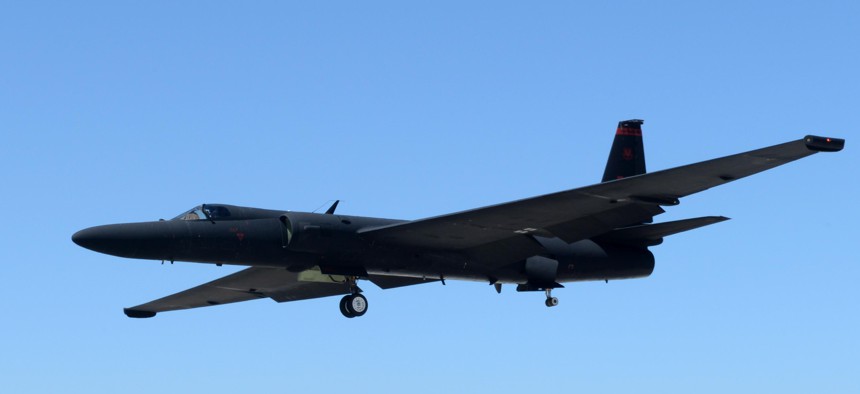
A U-2 Dragon Lady piloted by Maj. J.J., 1st Reconnaissance Squadron student pilot, prepares to land Aug. 31, 2016, at Beale Air Force Base, California. U.S. Air Force / Senior Airman Ramon A. Adelan
The U-2's Latest Feat: Passing Data from F-35s to Army Missiles
A recent demonstration used the old spy plane as an airborne comms relay between fighters and ground-based weaponry.
The venerable U-2 took another step toward the Pentagon's vision of 21st-century warfare, thanks to a recent demonstration in which it relayed sensor data from F-35 aircraft through Lockheed Martin communications gear to an Army missile-command system, company officials said Monday.
In a July Orange Flag demonstration at Edwards Air Force Base in California, the high-flying spy plane acted as an airborne communications node, collecting targeting data from Air Force F-35As. The F-35s also sent the data via a ground station to Lockheed’s Airborne Sensor Adaptation Kit to a surrogate Integrated Air and Missile Defense Battle Command System, or IBCS, a command system for Army missiles such as the PAC-3 interceptor or HIMARS artillery rockets.
The addition of the U-2 builds on a January demonstration in which F-35s passed data to an IBCS, which shot down test targets.
“F-35 data collected from the U-2 airborne relay will serve to validate that a single IBCS Airborne Sensor A-Kit can serve multiple pathways to get data from F-35 and ISR assets,” said the Lockheed statement, obtained by Defense One ahead of its official release.
Brad Just, a program director at Lockheed Martin’s missile and fires control division, said that integration could help the military much better protect ground forces from incoming threats.
“By tying that F-35 data through our A-Kit into IBCS, now we have immediate capability to combine that data with ground sensor data for air and missile defense and pipe that over and use it with our PAC-3 missile. We can use the F-35 data, whether they’re tracking incoming [tactical ballistic missiles] or, such as in these Orange Flag events, they’re tracking incoming aircraft. Or sometimes they’re even tracking cruise missiles or helicopters.”
The demonstration extends the range of the F-35 as a flying sensor, improves the effectiveness of the IBCS, and makes the decades-old U-2 more relevant to modern warfare. The U.S. military is at the beginning of a multi-year effort to interlink all its jets, drones, missiles, ships, and troops across air, land, sea, and space and across services, a vision referred to as Joint-Domain Command and Control. Every service has a role to play but the Air Force has the lead right now, with a program called the Advanced Battle Management System. The Air Force has been conducting new tests roughly every four months (though COVID delayed the most recent one scheduled for April.) The next one is scheduled for September. Orange Flag exercises are a way to test air-to-air combat capabilities. But starting with the August 2019 Orange Flag, they’ve come to serve complement to the ABMS tests, helping the Air Force better understand when interlinks are possible.
“We’ve demonstrated, we can use that for air defense roles as well as counter fire roles. “Orange Flag is showing the bottom-level tactical use of [Joint All-Domain Operations] whereas these ABMS operations...are a little higher level,” said Just. “They probably will come together at some point, especially by tying the F-35 to the airborne node through the U-2 that allows them to be broader in the J2 going forward.”
The breakthrough follows years of work at Lockheed Martin connecting the F-35 to other elements on the battlefield, such as the F-22, or, going back to 2016, the SM-3 IIA missile aboard Aegis destroyers.
“We’re going well beyond that here with these Orange Flag events, working to bring in not just air and missile defense but also bring in counterfires,” said Just. “Now, by having that airborne node through a U-2, that same sensor data could go to other joint domain operations in DOD, to other parts that have need for that same data."




